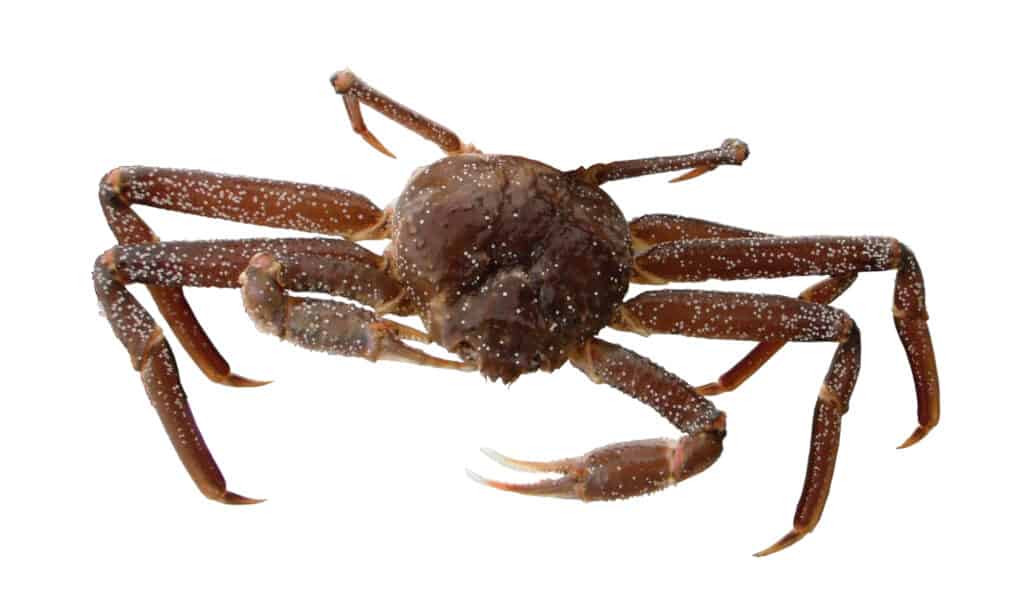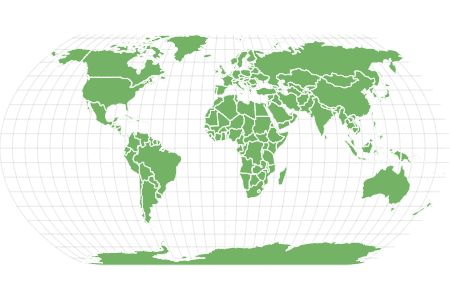Snow Crab
C. opilio
Snow crabs communicate with each other by waving or drumming their pincers.
Advertisement
Snow Crab Scientific Classification
- Kingdom
- Animalia
- Phylum
- Arthropoda
- Class
- Malacostraca
- Order
- Decapoda
- Family
- Oregoniidae
- Genus
- Chionoecetes
- Scientific Name
- C. opilio
Read our Complete Guide to Classification of Animals.
Snow Crab Conservation Status
Snow Crab Facts
- Prey
- Fish, shrimp, smaller crabs, clams
- Group Behavior
- Group
- Fun Fact
- Snow crabs communicate with each other by waving or drumming their pincers.
- Estimated Population Size
- Unknown
- Biggest Threat
- Ocean warming
- Other Name(s)
- Opie, opilio crab
- Gestation Period
- Up to two years
- Average Spawn Size
- Up to 100,000 eggs
- Diet for this Fish
- Carnivore
- Type
- Crustacean
- Common Name
- Snow crab
View all of the Snow Crab images!
The Snow Crab, also known as the Opie, is native to the northern parts of the Atlantic and Pacific Oceans, with high populations off the Alaskan coast. These crabs are an essential part of the commercial fishing industry, supplying countless seafood restaurants. Although these crustaceans have enjoyed healthy levels for fishing, ocean and climate change are threats to these creatures that may impact the price in the event of a shortage.
5 Snow Crab Facts
- Named for the color of its meat after it has been cooked
- Have four pairs of legs and one pair of claws
- Spend most of their lives on seafloors
- Live in groups known as clusters
- Eat mostly brittle creatures that they crush with their claws
Classification and Scientific Name
The Snow Crab’s scientific name is Chionoecetes opilio. Sometimes people refer to these crabs as opies or opilio crabs. These crabs are part of the Decapoda order, which includes 15,000 distinct species. Most of the species in this order are considered scavengers. Their family is Oregoniidae, encompassing several similar crab species.
Appearance
Snow Crabs have carapaces or brown or red shells, with yellow or white shading on the underside. This shading helps provide cover in the deep waters where these crabs live. The four pairs of legs help these crustaceans move effortlessly through Alaskan or North Atlantic ocean bottoms.

Snow crab on a white background
©Nick Kashenko/Shutterstock.com
Distribution, Population, and Habitat
In 2020, the National Oceanic and Atmospheric Administration (NOAA) estimated the commercial landings of Snow Crab in Alaska to number 36.6 million pounds. There has never been a shortage of crabs reported in the Pacific or the Atlantic, and NOAA does not consider the species subject to overfishing. Migration patterns for these crabs are not as well-known as with other species. The most significant population shifts have been observed in the Bering Sea, with numbers growing consistently.
Ocean currents help play a role in their distribution. These crabs live at varying depths from 66 to 265 feet. They can be found as far north as Greenland and as far south as the Gulf of St. Lawrence in the Atlantic Ocean. The habitat ranges from Siberia and Alaska to as far south as Korea when in the Pacific, with clusters having been found in all these locations.
Predators and Prey
Snow Crabs are often prey for other species and are subject to overfishing and climate change. For example, their meat is in high demand among people who enjoy seafood. With this demand comes the potential for overfishing, with some numbers of smaller Snow Crabs having dwindled. Warming ocean temperatures may also threaten these crabs because they are less likely to thrive in temperatures over 41 degrees Fahrenheit, which could lead to a shortage if water temperatures stay higher.
What eats snow crabs?
Humans are one of their most significant predators. Halibut also regularly eat these crustaceans, and larger Snow Crabs have been known to eat juveniles because their size makes them easy prey. Other predators include seals and squid, as well as the Alaskan King Crab.
Although Snow crabs have predators, they have shells that make it difficult for some predators to kill them. Their claws also serve as effective deterrents against predation.
What do snow crabs eat?
These crabs eat a variety of species that include smaller crabs, shrimp, and plankton. They are also capable of scavenging for food when prey is minimal.
Reproduction and Lifespan
Snow Crabs may live as long as 20 years. Female crabs may carry up to 100,000 eggs, provided there are adequate food supplies. The larvae hatch in the spring and go through several growth periods known as molting. These crabs molt for the last time at four years or later, which marks sexual maturity. Females usually reach this stage sooner than males.
Snow Crab in Fishing and Cooking
Snow Crab is a commercial seafood, attractive to many commercial fishing companies because of the price they get. Live traps that reach the seafloor level are the primary method of catching this crab. Peak seasons for catching this crab are January to April in the Pacific and April to August in the Atlantic. About 278 million lbs. of snow crab were harvested in 2020.
This type of crab has a firm texture, with a flavor described as salty and sweet. Many serve the meat shredded, similar to how corned beef is served.
Snow Crab is a favorite species worldwide, with the United States, Denmark, and China consuming the most. Other countries that consume a lot of this crab include Russia, Japan, and South Korea. It has 90 calories and 18.5 grams of protein per ounce, making it a healthy food choice for use in a variety of recipes.
View all 293 animals that start with SSnow Crab FAQs (Frequently Asked Questions)
What does snow crab taste like?
Snow crab has a sweet and salty taste that is milder than most other crab species.
Why is it called a snow crab?
The crab’s name comes from its meat color when cooked rather than its location.
What's the difference between king crab or snow crab?
Snow Crabs have legs that can be cracked by hand after they have been cooked, and King Crabs are also a larger species.
Where do snow crab live?
The Snow Crab lives in northern regions of the Pacific and Atlantic Oceans, with populations known to exist in the Barents Sea as well.
When are snow crabs in season?
Pacific Snow Crab season runs from January to April and Atlantic Snow Crab season runs from April to August.
Thank you for reading! Have some feedback for us? Contact the AZ Animals editorial team.
Sources
- A Classification of Living and Fossil Genera of Decapod Crustaceans, Available here: https://web.archive.org/web/20110606064728/http://rmbr.nus.edu.sg/rbz/biblio/s21/s21rbz1-109.pdf
- Animal Diversity, Available here: http://animaldiversity.org/accounts/Chionoecetes_opilio/
- Government of Canada, Available here: https://www.dfo-mpo.gc.ca/species-especes/profiles-profils/snow-crab-crabe-neiges-atl-eng.html
- NOAA Fisheries, Available here: https://www.fisheries.noaa.gov/species/alaska-snow-crab
- This Fish, Available here: https://thisfish.info/fishery/species/snow-crab/
- Quality Seafood Delivery, Available here: https://qualityseafooddelivery.com/2020/12/07/snow-crab-legs-season/
- Tradex Foods, Available here: http://www.tradexfoods.com/3mmi/2021/04-12-global-snow-crab-update
- Linked In, Available here: https://www.linkedin.com/pulse/world-crab-update-record-king-snow-imports-first-half-todd-wendt/

















